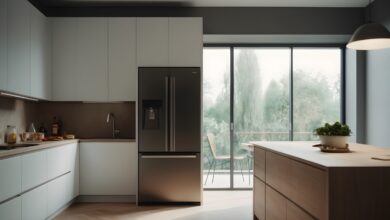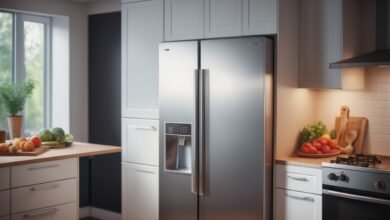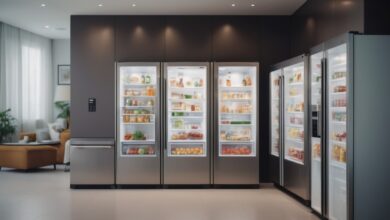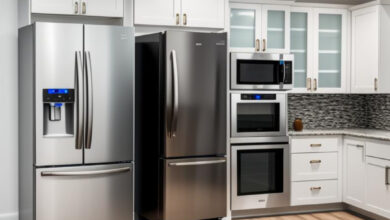Technology-Driven Innovations in Side-by-Side Refrigerator Designs
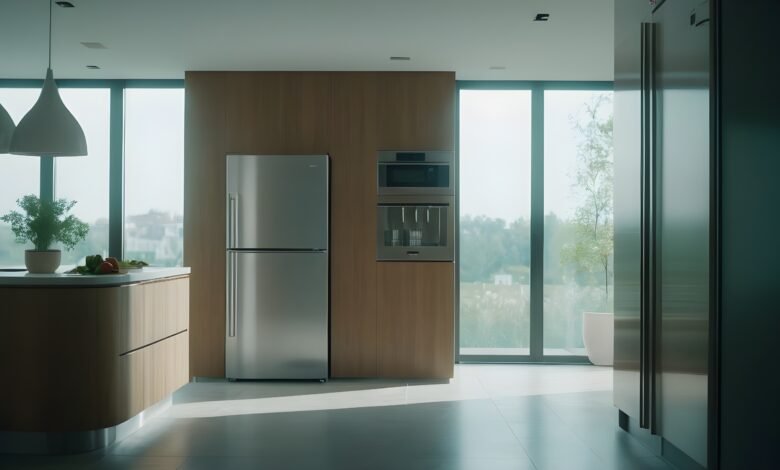
In the ever-evolving landscape of kitchen appliances, the humble refrigerator stands as a testament to technological innovation and consumer-centric design. The journey from icehouses to the sleek side-by-side refrigerators of today is a captivating narrative that intertwines historical developments, changing consumer preferences, and the relentless pursuit of efficiency and sustainability.
In this comprehensive exploration, we delve into the world of side-by-side refrigerator designs, dissecting the evolution of refrigeration from its historical roots to the latest technological advancements. From smart sensors and energy-efficient compressors to modular storage solutions and AI-driven features, every facet of these appliances is examined in detail.
Join us on a fascinating journey through the corridors of time, where we uncover the seamless integration of cutting-edge technology, sustainability practices, and personalized aesthetics in the realm of refrigeration. From the historical perspective of refrigeration’s development to the anticipation of future trends, this blog is your definitive guide to the state-of-the-art innovations transforming the way we preserve and interact with our food. Welcome to the revolution of refrigeration – where form meets function, and innovation shapes the heart of the modern kitchen.
I. Evolution of Refrigeration
A. Historical Perspective on the Development of Refrigerators
The journey of refrigeration is a captivating tale that begins with rudimentary methods and evolves into the sophisticated appliances we use today. In the 19th century, icehouses and cool chambers were early attempts at preserving perishables. However, it was the introduction of iceboxes that marked the first significant step towards modern refrigeration. These early iceboxes relied on the delivery of ice to keep food cool.
The turning point came in the 20th century with the advent of electric refrigerators. General Electric’s introduction of the first mass-produced electric refrigerator in 1927 transformed kitchens across the world. The transition from ice-based cooling to electrical refrigeration marked a paradigm shift, paving the way for continuous innovations in design, functionality, and sustainability.
B. Shift Towards Modern Designs and Consumer Preferences
The evolution of refrigerator designs is closely intertwined with shifting consumer preferences. Early refrigerators were functional but lacked the aesthetic appeal that modern consumers seek. In recent decades, there has been a pronounced shift towards designs that not only prioritize functionality but also seamlessly integrate into the overall aesthetics of contemporary kitchens.
Modern consumers view their kitchens as more than just utilitarian spaces—they are extensions of personal style. Manufacturers now recognize the importance of offering refrigerators with sleek exteriors, customizable finishes, and a harmonious integration with kitchen decor. The refrigerator has evolved from a mere appliance to a statement piece, reflecting the lifestyle and taste of the homeowner.
II. Efficiency and Energy-Saving Technologies
A. Smart Sensors for Precise Temperature Management
The integration of smart sensors into side-by-side refrigerators represents a breakthrough in temperature management. These sensors continuously monitor the internal climate, adjusting temperatures based on the specific requirements of stored items. The precision offered by smart sensors not only ensures optimal food preservation but also contributes to energy efficiency by minimizing unnecessary cooling cycles.
B. Energy-Efficient Compressors and Motors
Advancements in compressor and motor technologies have played a pivotal role in enhancing the energy efficiency of refrigerators. Modern compressors and motors are designed to operate with minimal energy consumption while maintaining high performance levels. This not only reduces electricity bills for consumers but also aligns with the industry’s commitment to sustainable practices.
C. Advancements in Insulation for Improved Energy Retention
In the pursuit of energy efficiency, innovations in insulation materials have become a focal point. Upgraded insulation ensures that the cold air generated by the refrigerator’s cooling system is retained more effectively. By minimizing temperature fluctuations, these advancements contribute to improved energy efficiency and, consequently, reduced environmental impact.
III. Space Optimization and Organization
A. Adjustable Shelving and Door Bins for Flexible Storage
The modern consumer’s dynamic lifestyle demands flexibility in storage solutions. Adjustable shelving and door bins in side-by-side refrigerators cater to this need, allowing users to customize the interior space according to the size and shape of their groceries. From accommodating large bottles to providing space for irregularly shaped items, this adaptability enhances convenience and maximizes storage efficiency.
B. Modular Storage Solutions Enhancing User Convenience
The introduction of modular storage solutions has transformed the way users organize their refrigerators. Manufacturers have incorporated removable and customizable drawers, shelves, and bins that adapt to diverse storage needs. Whether preparing for a special occasion or simply managing weekly groceries, these modular solutions enhance organizational capabilities, making it easier for users to keep their refrigerators tidy and accessible.
C. Innovative Interior Layouts Maximizing Usable Space
In the pursuit of maximizing usable space, refrigerator designers are exploring innovative interior layouts. Clever design considerations, such as optimizing the placement of shelves and storage compartments, ensure that every inch of the refrigerator is utilized efficiently. This not only increases the overall storage capacity but also improves accessibility, making it easier for users to locate and retrieve items.
IV. Connectivity and Smart Features
A. Integration with Smart Home Systems for Seamless Control
The integration of side-by-side refrigerators with smart home systems marks a significant leap in user convenience. With this connectivity, users can seamlessly control and monitor their refrigerators as part of their broader smart home ecosystem. From adjusting temperature settings to receiving notifications about maintenance requirements, this integration offers a new level of control and flexibility.
B. Wi-Fi Connectivity Enabling Remote Monitoring and Management
The evolution of Wi-Fi connectivity in refrigerators takes remote control to unprecedented levels. Users can connect their refrigerators to the internet, enabling real-time monitoring and management through dedicated mobile applications. This feature proves invaluable for those who want to check the contents of their fridge, adjust temperature settings, or receive maintenance alerts while on the go.
C. AI-Driven Features for Intelligent Food Organization and Tracking
Artificial Intelligence (AI) has become a driving force behind intelligent features in side-by-side refrigerators. AI algorithms analyze user behavior and preferences, offering suggestions for optimal storage configurations. These algorithms also contribute to reducing food waste by providing timely reminders for items approaching their expiration dates. The result is a refrigerator that not only preserves food but actively assists users in managing their inventory.
V. Food Preservation and Freshness Technologies
A. Advanced Air Purification Systems for Odor Control
Maintaining the freshness of stored items is not just about temperature control but also about controlling odors. Advanced air purification systems in modern refrigerators effectively neutralize and control odors, preventing cross-contamination of flavors between different food items. This ensures that each item retains its distinct taste and aroma, contributing to a more enjoyable culinary experience.
B. Humidity and Moisture Control Mechanisms for Optimal Food Preservation
Humidity and moisture control mechanisms have become integral to preserving the freshness of fruits, vegetables, and other perishables. Refrigerators now offer customizable settings that allow users to create specific microenvironments within the appliance. This attention to humidity levels contributes to prolonging the shelf life of produce, reducing food waste, and promoting sustainability.
C. UV-C Light Sterilization to Eliminate Bacteria and Extend Freshness
In the ongoing quest for enhanced food safety, UV-C light sterilization technology has been introduced in side-by-side refrigerators. This technology eliminates bacteria and microbes, providing an additional layer of protection for stored items. Not only does this contribute to maintaining a hygienic environment inside the refrigerator, but it also extends the freshness of perishable items.
VI. Design Aesthetics and Customization
A. Sleek and Modern Exterior Designs Complementing Kitchen Aesthetics
The external appearance of side-by-side refrigerators has undergone a significant transformation, evolving from bulky and utilitarian to sleek and modern designs. These appliances are now designed to complement various kitchen aesthetics, featuring clean lines, minimalist handles, and premium finishes. The result is a refrigerator that not only functions efficiently but also enhances the overall visual appeal of the kitchen space.
B. Customizable Finishes and Colors Catering to Diverse Consumer Preferences
Recognizing the diverse tastes of consumers, manufacturers have expanded the range of customizable finishes and colors for refrigerators. Whether it’s stainless steel, matte black, or bespoke color options, consumers now have the flexibility to choose an appliance that aligns with their personal style and complements the overall design scheme of their kitchen. This customization allows the refrigerator to seamlessly integrate into the unique aesthetic preferences of individual homeowners.
C. Harmonious Integration with Overall Kitchen Decor
Design considerations extend beyond individual aesthetics to ensure harmonious integration with the overall decor of the kitchen. Concealed controls
, integrated displays, and thoughtful placement of handles contribute to a cohesive and unobtrusive appearance. Refrigerators are no longer standalone appliances but integral elements that enhance the ambiance of the kitchen space, creating a visually pleasing and functional environment.
VII. Sustainability and Environmental Considerations
A. Utilization of Eco-Friendly Materials in Manufacturing
The shift towards sustainable practices in manufacturing is reflected in the choice of materials for side-by-side refrigerators. Manufacturers are increasingly opting for eco-friendly materials, such as recyclable plastics and bio-based insulation. This conscious choice contributes to reducing the environmental impact of refrigerator production, aligning with the growing demand for more sustainable consumer appliances.
B. Recycling Programs and Initiatives Promoting Environmental Responsibility
Addressing the issue of electronic waste, refrigerator manufacturers have implemented recycling programs and initiatives. These initiatives encourage consumers to responsibly dispose of their old appliances, ensuring that materials are recycled and reused wherever possible. By facilitating proper disposal channels, manufacturers actively promote environmental responsibility and contribute to reducing the overall ecological footprint of refrigerators.
C. Energy Star Ratings and Certifications Highlighting Sustainable Practices
Energy efficiency is a central focus in the design of modern refrigerators, with many models achieving Energy Star ratings and certifications. These designations indicate that a refrigerator meets stringent energy efficiency guidelines established by regulatory bodies. By choosing appliances with Energy Star ratings, consumers actively participate in promoting sustainable practices and reducing overall energy consumption on a larger scale.
VIII. Future Trends and Innovations
A. Predictive Maintenance Through AI Algorithms Ensuring Optimal Performance
Looking ahead, the future of side-by-side refrigerators involves the integration of predictive maintenance through AI algorithms. These sophisticated algorithms analyze usage patterns, temperature data, and other variables to predict potential issues before they occur. By providing proactive maintenance alerts, this technology ensures optimal performance, reduces the risk of breakdowns, and extends the overall lifespan of the appliance.
B. Integration of Biometric Authentication for Enhanced Security and Access Control
Biometric authentication is anticipated to play a significant role in enhancing security and access control in refrigerators. Fingerprint or facial recognition systems may be integrated into refrigerator designs, providing an additional layer of protection for stored food items and personal preferences. This feature addresses concerns related to privacy and security, contributing to the overall peace of mind for consumers.
C. Incorporation of Voice Assistants for Hands-Free Operation and Increased Convenience
The integration of voice assistants into side-by-side refrigerators represents the next step in the evolution of smart appliances. Voice recognition technology enables users to interact with their refrigerators using simple voice commands. This hands-free operation enhances convenience, allowing users to access information, adjust settings, and receive cooking recommendations without physically interacting with the appliance.
IX. Conclusion
A. Recap of Key Technological Innovations in Side-by-Side Refrigerator Designs
The journey of side-by-side refrigerator designs encapsulates a dynamic interplay between historical developments, technological advancements, and evolving consumer preferences. From the early days of basic cooling to the current era of smart, connected appliances, refrigerators have undergone a remarkable transformation.
B. Emphasis on the Impact of Technology on Consumer Lifestyles
The impact of technology on consumer lifestyles is evident in the multifaceted roles refrigerators now play in modern households. Beyond basic food preservation, these appliances contribute to efficiency, convenience, and even personalized experiences. The integration of technology aligns with the changing dynamics of how individuals interact with their kitchens, turning them into hubs of smart living.
C. Anticipation of Future Advancements in the Refrigeration Industry
Looking ahead, the refrigeration industry is poised for continuous innovation. The incorporation of predictive maintenance, biometric authentication, and voice assistants hints at a future where refrigerators become even more intuitive, efficient, and indispensable. As technology continues to shape the way we live, side-by-side refrigerators will remain at the forefront of this evolution, adapting to meet the ever-changing needs of consumers. Stay tuned for the unfolding of the next chapter in refrigeration technology, where advancements promise to redefine how we store, preserve, and interact with our food.
